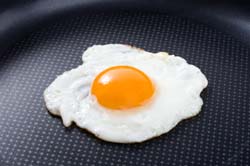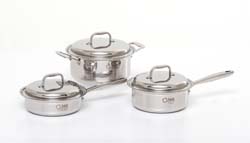
This egg was safe to eat… until you cooked it in this
You buy organic. You go to the local farmer’s market. You pay the extra price for pure foods.
It seems to take a lot of effort and expense these days to make sure your food is chemical-free and safe for you and your family.
But what would you say if I told you that your food may be dangerous – no matter how careful you are?
If you’re using any of the five dangerous cookware items below, what happens between the time you carefully choose your food and the time it hits the dining room table could be putting your family at risk for Alzheimer’s… organ damage… and even cancer.
Hopefully, you’ll do like I did and chuck those poisonous pans straight into the dumpster.
How do you know if your favorite cookware might be sickening you and your family?
Start by checking out this cookware safety list of no-no’s to discover the five most dangerous types of pots and pans.
The 5 Types of Poisonous Cookware to Avoid
#1 – Non-stick cookware
The “non-stick” part of your convenient pots and pans is a coating of fluoropolymers, which have been shown to give off perfluorooctanoic acid (PFOA) when heated.
Though the EPA has not yet “determined” if PFOA is a carcinogen, studies have shown it induces tumors in the liver, testes, and pancreas in rats. Other studies show that our bodies don’t metabolize PFOA, meaning it continues to build up over time.
We know from history that chemicals lingering in your body never leads to anything good. We also know that practically every person in the developed world has PFOA detectable in their blood.
Cookware manufacturers are working to completely eliminate PFOA in their products by 2015 – but that doesn’t mean you should wait around for “safe” Teflon.
Now, just because you shouldn’t use non-stick cookware doesn’t mean you have to say goodbye to your over easy eggs. Read on to discover a replacement that is much safer than non-stick – and it still won’t bust your egg yolks.
#2 — Copper pots and pans
Because copper is a soft metal, it is usually coated with nickel in pots and pans. However, that doesn’t stop them from getting into your food since both metals release metallic toxins when heated.
Copper is an essential trace mineral used for strengthening bones and connective tissue, energy production and immune system support. But according to Dr. Lawrence Wilson, excess copper can lead to connective tissue problems, vitamin C deficiency, high levels of estrogen and associated with various cancers.
Excess nickel is associated with heart disease, thyroid disease, and cancer. And you may be getting excessive exposure to both metals from the same dangerous cookware.
#3 — Lead-based cookware
Lead-based cookware? Sounds like you might as well tell your kids to go ahead and eat lead-based paint chips.
But it’s true: glass, ceramic, and enameled cookware are manufactured with lead. Lead is used to give the product rigidity and color uniformity. The glaze on some ceramics may also contain lead.
As you might expect, lead-based cookware leaches toxins straight into your beautifully prepared food.
Children under age six are particularly susceptible to lead poisoning. According to the Mayo Clinic, “exposure to even low levels of lead can cause damage over time. The greatest risk is to brain development.”
So don’t feed your kids from lead-based cookware any more than you’d feed them lead-based paint chips. And by all means, never cook or serve your food in anything labeled “for decoration only.” There’s usually a very good reason for the label.
#4 — Aluminum cookware
If there’s ever been any dangerous cookware you’ve heard about before, it’s likely aluminum. Warnings have abounded for years about aluminum toxicity and the link between excess aluminum and Alzheimer’s disease.
The reason you shouldn’t cook with aluminum cookware is the metal behaves the same way as the other metallic-based cookware we just covered… it leaches right into your food as you cook it. While better anondized aluminum cookware today leaches less, for your brain’s sake be safe and ditch the aluminum.
#5 — Cast Iron pans
For some reason many people forcefully maintain their opinion that cast iron pans don’t leach iron into your food.
Let me help you out… even though your mother swears by her cast iron griddle, the debate about whether iron leaches into your food or not has been long over.
In 1986, research published in the Journal of the American Dietetic Association clearly showed iron content in food increases dramatically when cooked in a cast iron pan. The most dramatic increase was with applesauce, which absorbed over 7mg of iron.
Now, the recommended daily intake of iron for a woman between 19 and 50 years old is 18mg. So the extra iron might even be a benefit for some women who tend to run low in iron. But for a child between 1 and 3 years old, their RDA is only 7mg.
This difference is important to note, as iron overload can lead to hemochromatosis and organ damage. So while cast iron is not the most dangerous cookware out there, if you use it, use discretion.
What about stainless steel?
One more type of cookware you may have heard some negative press about is stainless steel.
Stainless steel is made of a combination of metals includings iron, chromium, nickel, molybdenum, titanium, copper, and vanadium. Some inferior stainless steels do leach their alloyed metals into food, particularly if the cooking surface is damaged such as from harsh scouring with steel wool.
For safe cookware, look for one that uses an alloy of stainless steel called T-304. This alloy is non-leaching and safe for your food. And by investing in high-quality T-304 stainless steel cookware that evenly distributes heat you can still enjoy those perfect eggs over easy.
Our Favorite Recommended Safe Cookware

Enjoy great tasting food with peace of mind
CLICK HERE to
Learn More Now!
References
Klaunig J. Mode of Action analysis of perfluorooctanoic acid (PFOA) tumorigenicity and Human Relevance. Journal of Reproductive Toxicology. 2012 Jul;33(4):410-8.
Steenland K. Epidemiologic evidence on the health effects of perfluorooctanoic acid (PFOA). Environmental Health Perspectives. 2010 Aug;118(8):1100-8.
U.S. Environmental Protection Agency. Perfluorooctanoic Acid (PFOA) and Fluorinated Telomers. 2012 Feb 10.
Mercola J. A Special Report: Exposing the Dangers of Non-Stick Cookware. Mercola.com.
Stellpflug C. Is Your Cookware Killing You? Natural News. 2012 May 31.
Wilson, L. Copper Toxicity Syndrome. The Center for Development. 2011 Jul.
Mayo Clinic. Lead Poisoning: Complications. 2011 Mar 12.
Mineral Information Institute. The Role of Elements in Life Processes. 2012.
Brittin HC, Nossaman CE. Iron content of food cooked in iron utensils. Journal of the American Dietetic Association. 1986 Jul;86(7):897-901.
Office of Dietary Supplements. Dietary Supplement Fact Sheet: Iron. National Institutes of Health.
Mateljan, G. What is the healthiest type of cookware? George Mateljan Foundation. 2012.


The article on cookware is very informative &I recollect during my mother’s days when such cookware were not available except earthenware pots & iron pots or pans. As you have mentioned when cooked in iron pots iron getting leached to the vegetable or the materials which are cooked is very correct. I feel nowadays people are using SS vessel for cooking.
With regards,
S.Kailasam
I HAVE READ THAT OUR LOW IRON IN MODERN TIMES IS BECAUSE WE DONT USE CAST IRON POTS.AS FOR CER
I have read that our low Iron in modern time is because we dont cook in iron pots any more,after hundreds of years? As for ceramic cook ware,something we have cooked in for thousands of years,and being a potter,just make sure you cook in high fire pots with no lead glaze,buy American we don’t use Lead glaze!! Its more of how you cook to,and over heating the metal pots is bad. Bonaparte !!!
P.S. What about this New Stone and ceramic coated pans?? Ciao
I only use GLASS cookware and bakeware. If I have to use a different pan for something, then I use stainless steel.
If cast iron skillets leached too much iron into our systems, then we’d ALL be dead right? Or have massive problems from it. Our parents and grandparents used cast iron for all their cooking. So if it is as dangerous as some want us to believe, then how did any of us survive? I have cast iron, but I use my glass cookware and save the cast iron in case I ever have to cook over a fire. Never know what the future holds 🙂